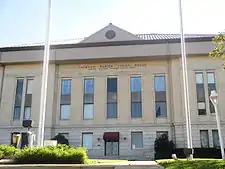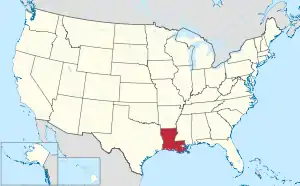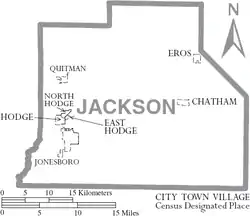Jackson Parish, Louisiana
Jackson Parish (French: Paroisse de Jackson) is a parish located in the northern part of the U.S. state of Louisiana. As of the 2010 census, the population was 16,274.[1] The parish seat is Jonesboro.[2] The parish was formed in 1845 from parts of Claiborne, Ouachita, and Union Parishes. In the twentieth century, this part of the state had several small industrial mill towns, such as Jonesboro.
Jackson Parish | |
|---|---|
Parish | |
| Parish of Jackson | |
 Jackson Parish Courthouse in Jonesboro | |
 Location within the U.S. state of Louisiana | |
 Louisiana's location within the U.S. | |
| Coordinates: 32°18′N 92°33′W | |
| Country | |
| State | |
| Founded | 1845 |
| Named for | Andrew Jackson |
| Seat | Jonesboro |
| Largest town | Jonesboro |
| Area | |
| • Total | 580 sq mi (1,500 km2) |
| • Land | 569 sq mi (1,470 km2) |
| • Water | 11 sq mi (30 km2) 1.9% |
| Population (2010) | |
| • Total | 16,274 |
| • Estimate (2018) | 15,902 |
| • Density | 28/sq mi (11/km2) |
| Time zone | UTC−6 (Central) |
| • Summer (DST) | UTC−5 (CDT) |
| Congressional district | 5th |
| Website | www |
East of Jonesboro is the Jimmie Davis State Park, which includes Caney Lake Reservoir.
History
Jackson Parish was founded in 1845 after Indian Removal and named for President Andrew Jackson.[3][4]
Civil War
During the American Civil War Confederate General Richard Taylor sent five companies into Jackson and Winn parishes to arrest conscripts who failed to report for duty, and to halt jayhawker groups in the area.
General Edmund Kirby-Smith had directed that
all men who shirked their military duty be hunted down and forced into camp. Those who tried to escape the conscript hunters would be shot. The terrain of Louisiana with its many canebrakes, swamps, and hills in which to hide, made such an order difficult to carry out,
explains the historian John D. Winters in The Civil War in Louisiana (1963).[5]
20th century to present
Jonesboro became an industrial mill town in the 20th century, producing lumber and turpentine products from the pine forests. Industrialization stimulated its growth. By the 1950s and 1960s, numerous African Americans had become industrial workers. Many were veterans of World War II and the Korean War, and they began to press to gain civil rights in the segregated state and region. Ku Klux Klan chapters were active here, and they intimidated and attacked civil rights activists.
In November 1964 Rev. Frederick Douglass Kirkpatrick, ordained that year as a minister of the Church of God in Christ, and Earnest "Chilly Willy" Thomas founded the Deacons for Defense and Justice, an organized African-American, armed self-defense group to protect activists and their families.
In February 1965, these two men and other CORE workers traveled 300 miles to Bogalusa, Louisiana, another small mill town, where they founded another chapter of the Deacons. They advised local activists on strategies of self-defense. They helped found chapters of the Deacons in other cities of Louisiana, as well as in Mississippi and Alabama in these years.
Geography
According to the U.S. Census Bureau, the parish has a total area of 580 square miles (1,500 km2), of which 569 square miles (1,470 km2) is land and 11 square miles (28 km2) (1.9%) is water.[6]
Major highways
 U.S. Highway 167
U.S. Highway 167 Louisiana Highway 4
Louisiana Highway 4 Louisiana Highway 34
Louisiana Highway 34
Adjacent parishes
- Lincoln Parish (north)
- Ouachita Parish (northeast)
- Caldwell Parish (southeast)
- Winn Parish (south)
- Bienville Parish (west)
Demographics
| Historical population | |||
|---|---|---|---|
| Census | Pop. | %± | |
| 1850 | 5,566 | — | |
| 1860 | 9,465 | 70.1% | |
| 1870 | 7,646 | −19.2% | |
| 1880 | 5,328 | −30.3% | |
| 1890 | 7,453 | 39.9% | |
| 1900 | 9,119 | 22.4% | |
| 1910 | 13,818 | 51.5% | |
| 1920 | 14,486 | 4.8% | |
| 1930 | 13,808 | −4.7% | |
| 1940 | 17,807 | 29.0% | |
| 1950 | 15,434 | −13.3% | |
| 1960 | 15,828 | 2.6% | |
| 1970 | 15,963 | 0.9% | |
| 1980 | 17,321 | 8.5% | |
| 1990 | 15,705 | −9.3% | |
| 2000 | 15,397 | −2.0% | |
| 2010 | 16,274 | 5.7% | |
| 2018 (est.) | 15,902 | [7] | −2.3% |
| U.S. Decennial Census[8] 1790–1960[9] 1900–1990[10] 1990–2000[11] 2010–2013[1] | |||
As of the census[12] of 2000, there were 15,397 people, 6,086 households, and 4,302 families residing in the parish. The population density was 27 people per square mile (10/km2). There were 7,338 housing units at an average density of 13 per square mile (5/km2). The racial makeup of the parish was 71.01% White, 27.87% Black or African American, 0.29% Native American, 0.21% Asian, 0.01% Pacific Islander, 0.24% from other races, and 0.37% from two or more races. 0.61% of the population were Hispanic or Latino of any race.
There were 6,086 households, out of which 31.70% had children under the age of 18 living with them, 52.80% were married couples living together, 14.40% had a female householder with no husband present, and 29.30% were non-families. 27.00% of all households were made up of individuals, and 13.50% had someone living alone who was 65 years of age or older. The average household size was 2.48 and the average family size was 3.01.
In the parish the population was spread out, with 25.30% under the age of 18, 9.30% from 18 to 24, 25.70% from 25 to 44, 23.60% from 45 to 64, and 16.20% who were 65 years of age or older. The median age was 38 years. For every 100 females there were 91.40 males. For every 100 females age 18 and over, there were 87.50 males.
The median income for a household in the parish was $28,352, and the median income for a family was $36,317. Males had a median income of $31,977 versus $19,992 for females. The per capita income for the parish was $15,354. About 16.00% of families and 19.80% of the population were below the poverty line, including 26.30% of those under age 18 and 15.80% of those age 65 or over.
Politics
Jackson Parish was historically part of the Solid South, as Louisiana had disenfranchised most blacks in the state at the turn of the century, as had other southern states. This made the Republican Party non-competitive in the state and region, and excluded blacks from politics into the 1960s. The conservative whites consistently voted for Democratic candidates in the one-party region. Governor Al Smith of New York received 100 percent of the vote in 1928 (from white voters) in his losing race against Herbert C. Hoover.[13]
In the 1960s, the majority of conservative white voters began to shift their support to Republican presidential candidates, and then to those at the state level. In 1960, Richard M. Nixon led parishwide with 43.9 percent against both John F. Kennedy and a rival slate of unpledged segregationist electors. These included future Governor David C. Treen and Leander Perez of Plaquemines Parish. In that election, blacks were still disenfranchised.[14]
Since the late 20th century, Democrat Bill Clinton and Republican George W. Bush each carried the parish twice. In 1992, Clinton polled 3,370 votes (44.5 percent) to Republican George Herbert Walker Bush's 3,072 (40.6 percent). Another 882 ballots (11.7 percent) were held by Ross Perot of Texas, who ran as an Independent and thereafter founded his Reform Party.[15]
In the 2008 U.S. presidential election, Republican U.S. Senator John McCain of Arizona outpolled Barack H. Obama of Illinois by 30 percentage points.[16] In 2012, Republican Mitt Romney carried Jackson Parish.with 5,132 votes (68.2 percent) to President Obama's 2,305 ballots (30.6 percent), a margin of nearly 38 percentage points and roughly equivalent to the proportion of races in the parish.[17] Most African Americans vote for Democratic candidates and overwhelmingly supported Obama in both of his elections.
| Year | Republican | Democratic | Third parties |
|---|---|---|---|
| 2016 | 69.3% 5,169 | 28.7% 2,139 | 2.1% 156 |
| 2012 | 68.2% 5,132 | 30.6% 2,305 | 1.2% 92 |
| 2008 | 67.1% 5,190 | 31.8% 2,456 | 1.2% 90 |
| 2004 | 65.9% 5,038 | 33.0% 2,525 | 1.1% 84 |
| 2000 | 61.2% 4,347 | 36.3% 2,582 | 2.5% 177 |
| 1996 | 42.9% 3,030 | 47.7% 3,368 | 9.5% 669 |
| 1992 | 40.6% 3,072 | 44.5% 3,370 | 14.9% 1,124 |
| 1988 | 58.6% 4,251 | 39.2% 2,842 | 2.2% 156 |
| 1984 | 64.9% 5,034 | 33.1% 2,568 | 2.1% 159 |
| 1980 | 50.8% 3,923 | 46.7% 3,609 | 2.6% 198 |
| 1976 | 46.9% 3,310 | 51.1% 3,605 | 2.1% 145 |
| 1972 | 70.0% 4,152 | 24.9% 1,477 | 5.2% 306 |
| 1968 | 16.8% 1,104 | 23.2% 1,525 | 60.0% 3,941 |
| 1964 | 74.4% 4,521 | 25.6% 1,552 | |
| 1960 | 43.9% 1,799 | 34.1% 1,398 | 22.0% 903 |
| 1956 | 54.3% 1,553 | 32.0% 916 | 13.7% 393 |
| 1952 | 36.4% 1,614 | 63.6% 2,817 | |
| 1948 | 7.4% 169 | 31.2% 713 | 61.5% 1,407 |
| 1944 | 18.3% 414 | 81.5% 1,840 | 0.1% 3 |
| 1940 | 9.3% 280 | 90.7% 2,734 | |
| 1936 | 8.6% 169 | 91.5% 1,807 | |
| 1932 | 1.9% 34 | 98.1% 1,748 | |
| 1928 | 0.0% 0 | 100.0% 907 | |
| 1924 | 11.4% 88 | 88.6% 682 | |
| 1920 | 11.9% 166 | 88.1% 1,229 | |
| 1916 | 2.7% 27 | 97.1% 980 | 0.2% 2 |
| 1912 | 2.5% 19 | 73.1% 561 | 24.4% 187 |
Education
Public schools in Jackson Parish are operated by the elected Jackson Parish School Board.
National Guard
A Company 199TH FSB (Forward Support Battalion) of the 256TH IBCT resides in Jonesboro, Louisiana. This unit has deployed twice to Iraq in 2004-5 and 2010. Also deployed in 1990 for Operation Desert Shield/Desert Storm.
Communities

Villages
Unincorporated communities
Notable people
- Rodney Alexander, Republican U.S. representative
- H. Welborn Ayres, judge of the Second Judicial District Court in Jonesboro, 1942–1953
- Robert C. Culpepper, Jackson Parish native, clerk of court from 1900 to 1908, state senator from 1908 to 1912, and judge in Alexandria from 1924 to 1942
- Marvin T. Culpepper, member of the Louisiana House of Representatives from Jackson Parish from 1964 to 1968
- Jimmie Davis, Democratic former governor and singer by profession, born in Jackson Parish in 1899.
- Randy Ewing, former Louisiana State Senate President and a 2003 Democratic gubernatorial contender.
- James R. Fannin, state representative from Jackson Parish since 2003
- E.L. "Bubba" Henry, former Democratic Speaker of the Louisiana House of Representatives, served in the House from District 13 from 1968 to 1980, the last eight of those years as Speaker
- Berry Hinton, native of Clay/Vernon communities; baseball coach at Louisiana Tech University from 1943 until 1967
- Arnold R. Kilpatrick, former president of Northwestern State University in Natchitoches
- Robert W. Mondy, historian at Louisiana Tech University who taught in Jackson Parish public schools in the early 1930s
- Robert Edwin Russ, the founder of Ruston, lived in Jackson Parish before moving to Lincoln Parish.
- James Monroe Smith, Jackson Parish native who served as president of Louisiana State University from 1930 to 1939; forced to resign in "Louisiana Hayride" scandals of 1939[19]
- George T. Walker, president of the University of Louisiana at Monroe from 1958 to 1976, was born and reared in the Wyatt Community of Jackson Parish.[20]
- William Stewart Walker, World War II United States Army officer; Republican congressional candidate, 1964; younger brother of George T. Walker.
Gallery
 A portion of Caney Lake east of Jonesboro
A portion of Caney Lake east of Jonesboro The Jackson Parish Veterans Memorial is located across from the parish library in Jonesboro.
The Jackson Parish Veterans Memorial is located across from the parish library in Jonesboro. The Jackson Parish Museum and Fine Arts Association is located at 515 South Cooper Avenue in Jonesboro across from the First Baptist Church.
The Jackson Parish Museum and Fine Arts Association is located at 515 South Cooper Avenue in Jonesboro across from the First Baptist Church. The Jackson Parish Library in Jonesboro
The Jackson Parish Library in Jonesboro
See also
- Historical romance author Jennifer Blake lives in Quitman.
- National Register of Historic Places listings in Jackson Parish, Louisiana
References
- "State & County QuickFacts". United States Census Bureau. Archived from the original on June 6, 2011. Retrieved August 9, 2013.
- "Find a County". National Association of Counties. Archived from the original on May 31, 2011. Retrieved June 7, 2011.
- "Jackson Parish". Center for Cultural and Eco-Tourism. Retrieved September 4, 2014.
- Gannett, Henry (1905). The Origin of Certain Place Names in the United States. Govt. Print. Off. pp. 167.
- John D. Winters, The Civil War in Louisiana, Baton Rouge: Louisiana State University Press, 1963, ISBN 0-8071-0834-0, p. 306
- "2010 Census Gazetteer Files". United States Census Bureau. August 22, 2012. Archived from the original on September 28, 2013. Retrieved September 1, 2014.
- "Population and Housing Unit Estimates". Retrieved October 29, 2019.
- "U.S. Decennial Census". United States Census Bureau. Retrieved September 1, 2014.
- "Historical Census Browser". University of Virginia Library. Retrieved September 1, 2014.
- "Population of Counties by Decennial Census: 1900 to 1990". United States Census Bureau. Retrieved September 1, 2014.
- "Census 2000 PHC-T-4. Ranking Tables for Counties: 1990 and 2000" (PDF). United States Census Bureau. Retrieved September 1, 2014.
- "U.S. Census website". United States Census Bureau. Retrieved May 14, 2011.
- David Leip Election Atlas: 1928 statistics
- Louisiana Secretary of State, Presidential election returns by parish, November 8, 1960
- "Jackson Parish presidential election returns, November 3, 1992". staticresults.sos.la.gov. Retrieved November 17, 2012.
- The New York Times electoral map (Zoom in on Louisiana)
- "Jackson Parish presidential election returns, November 6, 2012". staticresults.sos.la.gov. Retrieved November 17, 2012.
- Leip, David. "Dave Leip's Atlas of U.S. Presidential Elections". uselectionatlas.org. Retrieved March 7, 2018.
- "Smith, James Monroe". A Dictionary of Louisiana Biography (Louisiana Historical Association). Archived from the original on July 16, 2016. Retrieved March 25, 2011.
- "George T. Walker". Monroe News Star. Retrieved July 6, 2011.